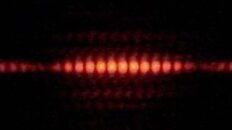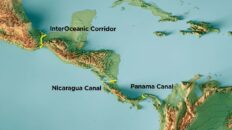The internet has been abuzz with news of a potential room temperature (and pressure) superconductor and all the ways that it could change the world. Unfortunately, in pretty quick order the material called LK-99 has been proven to be not superconductive at all. Here’s a brief synopsis of how that went down, along with other questions in today’s Lightning Round video!
TRANSCRIPT:
Let’s start this month’s lightning round video off with some superconductor news. Maybe you heard about it.
The superconductor I’m talking about is, of course, metal strontium ruthenate.
I am not making that up.
Technically it’s not a demon it’s a dem-on. It stands for distinct electron motion particle, and they add the -on to particle names. Electron, proton… dem-on.
It was first theorized by David Pines in 1956, so it’s been called Pine’s Demon, it’s a type of plasmon that’s massless and has a neutral charge.
Mostly this is news just because nobody’s ever seen one before, but it’s hoped that studying this particle – or quasiparticle technically – will help us to understand superconductors better.
And speaking of superconductors…
Brian Beswick
LK99, the next great leap in science, or a Cold Fusion like debacle?
Yeah, this question was asked a few weeks back.
So when the news of LK99 came out, of course I had about a million requests to cover this topic, but I didn’t for a few reasons
- Had a backlog of videos
- I didn’t feel confident that I understood the details beyond the hype
- It all just sounded too good to be true
I would rather be the guy who waits a few weeks to make sure something is legit before I talk about it than just jump on board a hype cycle. Which probably explains the slow growth of my channel.
But at this point the verdict seems to be in and it looks like I was right to be so skeptical. And I don’t think I have any clairvoyance or anything, but I’ve seen a lot of “world changing” announcements in the time I’ve done this channel and most of them when all is said and done turn out to be nothingburgers.
Been burned too many times kids. I can only play Charlie Brown for so long
But I guess it’s possible some of you haven’t heard of LK99, there have been… a lot of other things in the news lately.
By the way, our hearts go out to everybody in Maui that was affected by those fires and also, as I say this the city of Yellowknife in Canada is being evacuated because of wildfires up there. So that may or may not exist by the time this comes out.
But on top of all of that, the internet went crazy in late July when a preprint hit the social media feeds reporting that a team in South Korea had created a substance that is superconductive at room temperature and ambient pressure.
Superconductivity is when a material offers no resistance to an electrical current and it does all kinds of cool things like levitate. And it’s useful in things like MRI machines and fusion reactors to direct magnetic fields.
The downside to superconductors though is that all of them so far need to either be cooled to just above absolute zero or it has to be under massive pressure, like supposedly there’s a layer of metallic hydrogen on Jupiter that’s created by the massive gravitational pressure.
Anyway, the idea of a room temperature, ambient pressure superconductor would mean that our electrical grids would be super efficient, we could have maglev trains, maglev cars – hoverboards, people!
Hence the massive amount of hype around this discovery.
The people behind it was a team led by Sukbae Lee and Ji-Hoon Kim at the Quantum Energy Research Centre, which is a start-up firm in Seoul. And they claimed this worked at normal pressures up to 127 ºC.
And of course there’s the video we’ve all seen of a little flake of the material levitating, and one of the best things about it, it didn’t require any rare materials, it was all copper, lead, phosphorus and oxygen. And the preprint showed how to make it.
So people all over the world – professionals and amateurs alike – started trying to replicate it. And the tweets started coming at me immediately.
I’ll get to the results of those replication efforts in a second, but for me anyway, there were a couple of red flags right off the bat, one this was a pre-print, meaning it hadn’t been peer reviewed, and, again… Charlie Brown.
The second was the this wasn’t an academic institution, this was from a start-up, meaning they had a monetary incentive to be the first to get this out there.
Nothing against startups, just saying.
And it looked at first like maybe there was something to it, some labs were able to replicate the effect that we saw in the footage, but others weren’t. And even the ones that did began to question if what they were seeing was actually from superconductivity.
Many suggested the effect was actually from ferromagnetism instead of the Meissner Effect, which is what causes the levitation in superconductors.
And as of this recording, that seems to be the consensus.
According to this article in the Journal Nature, the effect was the result of copper sulfide impurities in the Korean sample.
He recognized something specific in the preprint that said that the superconductivity of LK-99 went way up at 104.8 ºC. And according to the article, he said, “I was like, wait a minute, I know this temperature.”
He knows that temperature because he happens to be an expert in copper sulfide, he’s worked with it extensively, and he knows that at that exact temperature, copper sulfide goes through a phase transition where its resistivity goes way down.
This prompted a team at the Chinese Academy of Sciences (CAS) to experiment with a couple of different methods of making LK-99 samples, one done in a vacuum, which included 5% Cu2S content, and the second in air, which gave 70% Cu2S content.
And the one with 70% copper sulfide acted a lot like the Korean sample, the one with only 5% behaved very differently. And that seems to have sealed the deal.
According to Michael Fuhrer, a physicist at Monash University in Melbourne, Australia,
“That was the moment where I said, ‘Well, obviously, that’s what made them think this was a superconductor,’” says Fuhrer. “The nail in the coffin was this copper sulfide thing.”
But one could say the final nail in the coffin was a test on August 14th by a team from the Max Planck Institute for Solid State Research in Stuttgart, Germany.
They were able to make a sample of completely pure, copper sulfide-free LK-99 using a method called floating zone crystal growth that turns out made some really cool purple translucent stones.
Dude, they made the power stone!
More important than how it looks though, was the fact that it didn’t have any superconductor properties at all. It showed some ferromagnetism and diamagnetism, but it couldn’t even partially levitate like the Korean sample. Their paper ended by saying, “We therefore rule out the presence of superconductivity.”
Yeah. Welcome to bummer town.
It should be said though, a lot of the hype around this was way overblown in the first place, there was a long string of “ifs” between this paper and flying cars – there was a line from an article in Scientific American that stood out to me:
“If LK-99 were a superconductor, if it could withstand high currents, if it weren’t too brittle to form into wire, if it were easy and cheap to synthesize, if the materials for its manufacture could be readily acquired, and if policy and funding followed suit, then maybe it could provide a small boost for energy efficiency a decade or more down the line.”
Yeah, a lot of the rhetoric around this revolved around making our grids more efficient and how that would be a big boost in the fight against climate change, but our current grid only loses 5% of its energy to heat, and 5% isn’t going to solve climate change.
There’s a lot of already-there technology available that could make our infrastructure more efficient that we’re not doing right now.
Advancements in energy storage would go much further in that regard.
But still, there are some interesting qualities of LK-99 and research is ongoing, and you never know what kind of ripple effects that research could create, so we might not be done with it yet.
As for it being a “debacle” as you mentioned, I wouldn’t call this a debacle, honestly, I think this has been a great demonstration of how science works; how peer review works. And someday we’ll see something go through that peer review process, whether it’s superconductivity or energy storage, or carbon capture, and it’ll come out shining on the other end. And that might be the thing that changes the world.
You’ve just gotta go through these bumps in the road to get there.
Thomas Lovse
Hi Joe, I have a question for you, why do we humans find music so pleasant? Why do some people prefer to listen to Bach, whilst others prefer rap music, or pop music. And also, what does listening to and performing music do to the brain?
- The way it hacks the brain
- The universality of the pentatonic scale
- Point to Nebula music creators – Adam Neely, 12Tone, Amy Nolte
Fishtail – July – Discord
What is the most annoying “eggcorn” you have encountered? What is your favorite?
Here is a video that explains the difference between eggcorns, mondegreens, malapropisms, and folk etymologies. https://www.youtube.com/watch?v=F12LSAbos7A
donasalyer – August – Discord
I grew up with the horror staples of vampire, ghosts, werewolf, possession, and, of course, zombies. None of these genres had priority over the other, although there could be waves of vampire movies and books or possession movies and books. Until – at some point – Zombies became the ‘It Girl’ of the horror standard in books, movies and TV.
What caused the Zombie story to become the predominant in horror over the others to the degree that it has? This seems to have been going on for 15 or so years, at this point.
It’s been going a lot longer than that
- History of zombies – Caribbean culture
- Came from west African traditions in Haiti
Types of zombies
- supernatural zombies, brought back by some curse or demonic uprising
- Later became analogous to diseases and plagues; viruses, then fungus (the last of us)
One of the reasons zombie apocalypse stories are so popular right now is it’s analogous to societal breakdown.
Well before the pandemic, post 9/11, advent of the internet, rapid technological advancement, people feeling that society is spinning out of control
Speaks to our collective fear that all this is going to come crashing down.
Maybe an even darker take is it speaks to our desire for it all to come crashing down, for society to start again and maybe correct the problems we caused.
Philip Shane – August – Discord
I just read this and it seems fishy to me. Joe, what say ye? Does Standard Gauge go all the way back to Roman Chariots?
Had to turn to good ol’ Snopes for this one.
Philip pointed me to this viral post that talked about how Roman chariots were pulled by two horses and therefore were designed to be as wide as two horses, which came out to about 4 feet, 8 1/2 inches.
This put grooves in the roads at that width and just became the standard width for wagons in Roman occupied Europe.
Later as the railroads came about, they made the gauge of the tracks the same width because the wagons were already at that width and the first vehicles on train tracks were those wagons
not to mention all the parts had been standardized to that width, etc.
So as the railroads were being built here in the US, the same thing happened, according to this post because the builders of the railroad were British?
And then it caps it all off by mentioning that when the Space Shuttle was built, the solid rocket boosters were made a certain size so that they could fit through railroad tunnels, which were of course designed around that same 4’ 8.5” gauge.
The point being that even the most modern technology was designed around ancient Roman technology, which was based on the width of a horse’s ass.
ANYWAY… I’ll admit that’s a fun bit of trivia, perfect fodder for this channel.
But it’s kinda only half true.
According to Snopes, there was definitely some technological and cultural inertia in that road size and the Romans definitely had a massive cultural impact on the lands they occupied.
But it breaks down a bit when the train gauge was established, especially in the US.
Because there were actually several gauges at first and it didn’t standardize until after the Civil War. In fact, according to historian James McPherson, one of the reasons the South lost the war is because they were slower to standardize than the North
There were multiple rail companies in the South that had their own gauges and this caused issues transporting goods.
As for the Shuttle booster thing, that’s kinda totally bunk, the company Thiokol who made the boosters didn’t have any size restriction because of train tunnels, they could have easily sent it by boat to its destination. Besides, tunnels are only vaguely based on the gauge because there are all kinds of cargo that travels through the tunnels and it needs to be big enough to accommodate.
But still. Fun exercise in the domino effect.




Add comment